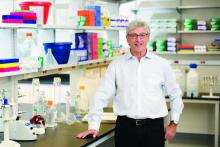Potential etiologic role of P. copri
Another paper, published in Arthritis & Rheumatology by some of the same investigators a week before the study describing the Subdoligranulum findings, tried to ascertain the point at which individuals might develop antibodies to P. copri, which for about a decade has been suspected of having a link to the development of RA.
They found that those with early RA had higher median values of IgG anti–P. copri (Pc) antibodies, compared with matched controls. People with established RA also had higher values of IgA anti-Pc antibodies. Those with ACPA, but not rheumatoid factor (RF), showed a trend toward higher IgG anti-Pc antibodies. Those who were ACPA-positive and RF-positive had significantly increased levels of IgA anti-Pc antibodies and a trend toward higher levels of IgG anti-Pc antibodies, compared with matched controls.
The findings, according to the researchers, “support a potential etiologic role for this microorganism in both RA preclinical evolution and the subsequent pathogenesis of synovitis.”
Dr. Kuhn and others in the field say it’s likely that many microbes play a role in the development of RA, and that the P. copri findings only add evidence of that relationship.
“Maybe the bacteria are involved at different parts of the pathway, and maybe they’re involved in triggering different parts of the immune responses,” she said. “Those are all to be determined.”
Dan Littman, MD, PhD, professor of rheumatology at New York University, who wrote a commentary reflecting on the findings of the Subdoligranulum study, said the results are “another piece of data” adding to the evidence base for the mucosal origins hypothesis.
“It’s by no means proven that this is the way pathogenesis in RA can occur, but it’s certainly a very solid study,” said Dr. Littman, who with colleagues published findings in 2013 linking P. copri to RA. “What makes it most compelling is that they seem to be able to show some evidence of causality in the mouse model.”
Before the findings could lead to therapy, he said, more evidence is needed to show that there is a causal link, and on the mechanism at work, such as whether this is something that occurs at the outset of disease or is something that “fuels the disease” by continually activating immune cells contributing to RA.
“If it’s only something that’s involved in the initiation of the disease, you need to catch it very early,” he said. “But if it’s something that continues to provide fuel for the disease, you may be able to catch it later and still be effective. Those are really critical items.”
Eventually, if these questions are answered, bacteriophages could be developed to snuff out problematic strains, or the regulatory response could be targeted to prevent the activation of the B cells that give rise to autoimmunity, he suggested.
“There are multiple steps to get to a therapeutic here, and I think we’re still a long ways from that,” he said. Still, he said, “I think it’s an important paper because it will encourage more people to look at this mechanism more closely and determine whether it really is representative of what happens in a lot of RA patients.”
The study in Science Translational Medicine was supported by grants from the National Institutes of Health, a Pfizer ASPIRE grant, and a grant from the Rheumatology Research Foundation. The Arthritis & Rheumatology study was supported in part by grants from the National Institutes of Health; the American College of Rheumatology Innovative Grant Program; the Ounsworth-Fitzgerald Foundation; Mathers Foundation; English, Bonter, Mitchell Foundation; Littauer Foundation; Lillian B. Davey Foundation; and the Eshe Fund. None of the researchers in either study had relevant financial disclosures. Dr. Littman is scientific cofounder and member of the scientific advisory board of Vedanta Biosciences, which studies microbiota therapeutics.


